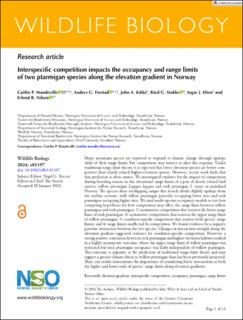Interspecific competition impacts the occupancy and range limits of two ptarmigan species along the elevation gradient in Norway
Mandeville, Caitlin P.; Finstad, Anders G.; Kålås, John A.; Stokke, Bård G.; Øien, Ingar J.; Nilsen, Erlend Birkeland
Peer reviewed, Journal article
Published version
Permanent lenke
https://hdl.handle.net/11250/3126577Utgivelsesdato
2024Metadata
Vis full innførselSamlinger
Originalversjon
Mandeville, C. P., Finstad, A. G., Kålås, J. A., Stokke, B. G., Øien, I. J. & Nilsen, E. B. (2024). Interspecific competition impacts the occupancy and range limits of two ptarmigan species along the elevation gradient in Norway. Wildlife Biology: e01197. doi: 10.1002/wlb3.01197Sammendrag
Many mountain species are expected to respond to climate change through upslope shifts of their range limits, but competition may restrict or alter this response. Under traditional range-limit theory, it is expected that lower-elevation species are better competitors than closely related higher-elevation species. However, recent work finds that this prediction is often unmet. We investigated evidence for the impact of competition during breeding season on the elevational range limits of a pair of closely related bird species, willow ptarmigan Lagopus lagopus and rock ptarmigan L. muta, in mainland Norway. The species share overlapping ranges that loosely divide slightly upslope from the treeline ecotone, with willow ptarmigan generally occupying lower sites and rock ptarmigan occupying higher sites. We used multi-species occupancy models to test four competing hypotheses for how competition may affect the range limit between willow ptarmigan and rock ptarmigan: 1) asymmetric competition that restricts the lower range limit of rock ptarmigan; 2) asymmetric competition that restricts the upper range limit of willow ptarmigan; 3) condition-specific competition that restricts both species’ range limits; and 4) range limits unaffected by competition. We found evidence for a negative pairwise interaction between the two species. Changes in interaction strength along the elevation gradient suggested evidence for condition-specific competition. However, a strong positive correlation between rock ptarmigan and higher-elevation habitat resulted in a highly asymmetric outcome, where the upper range limit of willow ptarmigan was restricted but rock ptarmigan occupancy was fairly independent of willow ptarmigan. This outcome is opposite to the prediction of traditional range-limit theory and may suggest a greater climate threat to willow ptarmigan than has been previously projected. Thus, our results demonstrate the importance of considering biotic interactions at both the higher and lower ends of species’ range limits along elevation gradients. elevation gradient, interspecific competition, occupancy, ptarmigan, range limits

